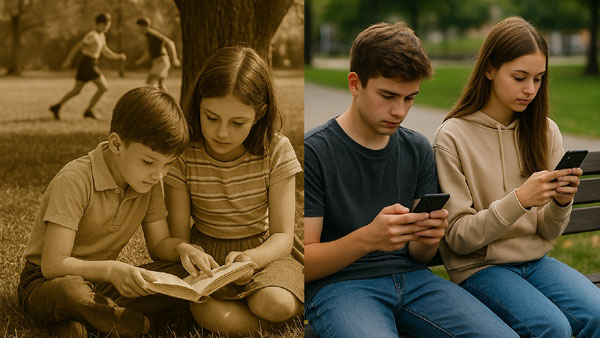By Satyabrat Borah
The rapid evolution of technology and its profound impact on society have sparked endless debates about generational differences, particularly in how people spend their time. A common narrative often emerges: older generations claim they were different, more engaged with meaningful activities like reading books or playing outdoors, while today’s youth are often labeled as “mobile-addicted,” wasting hours scrolling through short videos or “reels” on social media platforms. However, this perspective oversimplifies the reality. If those from earlier generations had been born after 2010, they might have found themselves just as captivated by smartphones and digital entertainment as today’s youth. The truth is, every generation is shaped by the context of its time ,its technology, environment and societal norms. The differences we observe are not necessarily a reflection of character or values but rather the inevitable influence of the era one grows up in.
Consider the world before the advent of smartphones and the internet. For those born in the mid-20th century, entertainment and leisure were vastly different. Without the constant connectivity we take for granted today, people turned to what was available. In rural areas, children might have spent their afternoons playing in fields, climbing trees, or engaging in community games. In urban settings, families gathered around a single radio or, later, a television set, for their dose of entertainment. Books were a primary source of knowledge and imagination, often passed down through generations or borrowed from local libraries. Social interactions were face-to-face and free time was spent in activities that required physical presence whether it was playing sports, attending cultural events, or simply sitting with family and neighbors to share stories. This was the reality of the time, and it shaped the habits and preferences of those who lived through it.
Fast forward to the present, and the landscape has changed dramatically. The rise of the internet, followed by the proliferation of smartphones, has transformed how we live, work, and play. For the younger generation, often referred to as Gen Z or Gen Alpha, technology is not just a tool—it’s an integral part of their existence. Smartphones are ubiquitous, offering instant access to a world of information, entertainment, and social connection. Platforms like Instagram, TikTok, and YouTube have introduced short-form video content, such as reels, which are designed to capture attention quickly and hold it with engaging, bite-sized clips. These platforms are not just sources of entertainment; they are also spaces for creativity, self-expression, and learning. A teenager today might watch a reel to learn a new dance move, discover a quick recipe, or even pick up a language tip—all in under a minute. The appeal of such content is undeniable, especially in a fast-paced world where time feels scarce and instant gratification is valued.
Older generations often critique this shift, pointing out that today’s youth seem glued to their screens, disconnected from the “real world.” They reminisce about their own childhoods, filled with outdoor play, reading, and meaningful social interactions. But this comparison overlooks a crucial point: if those same older individuals had grown up in the current era, with the same technological advancements at their fingertips, they might have developed similar habits. Imagine a child of the 1960s, who spent hours reading novels or playing in the park, being born instead in 2015. With a smartphone in hand from a young age, they would likely be just as drawn to the endless stream of videos, games, and social media interactions as today’s children are. The allure of technology is not a failing of character.It’s a natural response to the environment one is raised in.
The influence of time and context on behavior cannot be overstated. Each era brings its own set of tools, opportunities, and challenges, which shape how people live their lives. In the past, the absence of digital devices meant that people had to find other ways to occupy their time. Reading books, for instance, was not just a pastime but a necessity for education and entertainment in a world with limited media options. Outdoor play was the default for children because there were fewer indoor distractions. Social bonds were strengthened through physical presence because there was no alternative like video calls or instant messaging. These activities were not chosen because people were inherently more disciplined or virtuous.They were simply the most accessible and practical options available.
Today, the scenario is different. Technology has made information and entertainment more accessible than ever before. A smartphone can serve as a library, a gaming console, a movie theater, and a social hub, all at once. For a teenager, watching reels might seem like a waste of time to an older observer, but it’s often a way to unwind, connect with friends, or even learn something new. Moreover, the fast-paced nature of modern life leaves little room for the leisurely activities of the past. With academic pressures, extracurricular commitments, and the constant demand to stay connected, young people often turn to their phones for quick bursts of relaxation. A 30-second reel can provide a moment of laughter or inspiration in the midst of a hectic day, something that a lengthy novel or an outdoor game might not fit into as easily.
This is not to say that the younger generation has abandoned traditional activities entirely. Many still read books, play sports, and spend time with family and friends. However, the way these activities are integrated into their lives has changed. A teenager might read an e-book on their phone instead of a physical copy, or they might play an online game with friends instead of meeting at a park. The core desires to learn, to connect, to have fun remain the same, but the methods have evolved with the times. Technology has not replaced these activities; it has transformed them, often making them more accessible and convenient. For instance, a child in a remote village can now access a vast library of books online, something that would have been unimaginable a few decades ago.
The generational divide in how time is spent also reflects broader societal shifts. In the past, life moved at a slower pace. People had more time to engage in activities that required patience and focus, like reading a 500-page novel or spending an entire afternoon playing outdoors. Today, the world is more interconnected and fast-paced. The pressure to keep up with global trends, academic expectations, and social dynamics has intensified. For young people, technology offers a way to navigate this complexity. Social media platforms, including those hosting reels, are not just sources of entertainment.They are also spaces where trends are set, identities are explored, and communities are built. A teenager watching a reel is often doing more than passing the time; they are participating in a global cultural exchange, learning what’s popular, and finding their place in a rapidly changing world.
Rather than criticizing the younger generation for their reliance on technology, it’s worth considering how society can guide them to use it more effectively. The potential of smartphones and digital platforms is immense, but so are the risks, such as excessive screen time or exposure to harmful content. Education plays a crucial role here. Teaching young people how to balance their digital consumption with other activities, how to discern credible information from misinformation, and how to use technology for personal growth can help them harness its benefits while minimizing its downsides. For example, encouraging the use of educational apps, online courses, or creative tools can turn a device that’s often blamed for distraction into a powerful instrument for learning and self-improvement.
The differences between generations are less about inherent qualities and more about the circumstances they were born into. The older generation’s love for books and outdoor play was a product of their time, just as the younger generation’s affinity for reels and smartphones is a product of theirs. Both groups have adapted to their environments, finding ways to learn, connect, and find joy in the tools available to them. Instead of judging one another, there’s an opportunity for mutual understanding. The older generation can share the value of slower, more focused activities, while the younger generation can teach the older one how to navigate the digital world with ease. By bridging this gap, we can create a future where technology and tradition coexist, allowing each generation to learn from the other and thrive in a world that continues to evolve.




